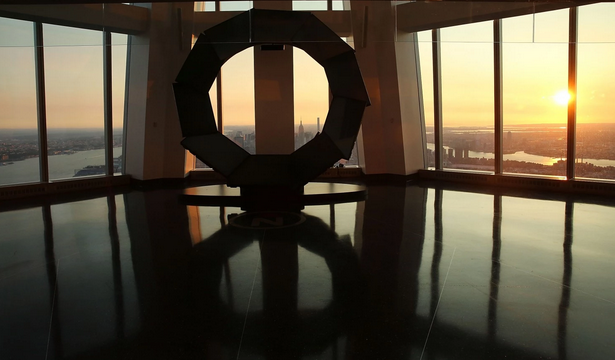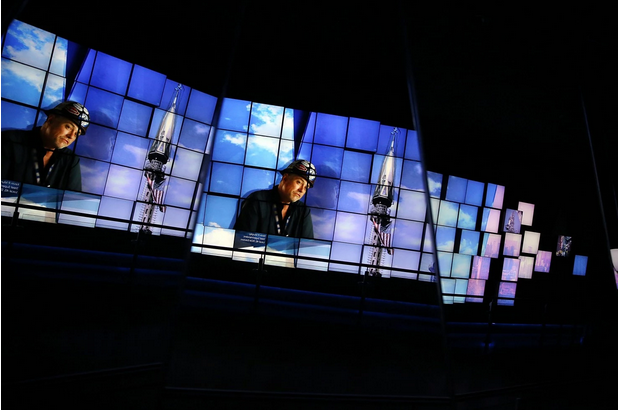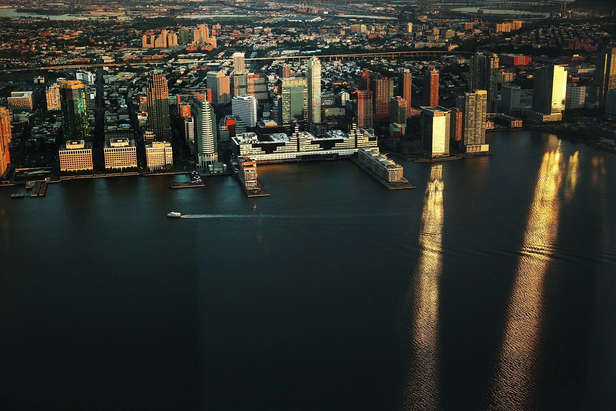
Atop New York’s One World Trade Center, a rush of hope and memories
By Stephanie Citron

The sun rises outside the One World Observatory at One World Trade Center, the former site of the twin towers, on opening day in May in Lower Manhattan. (Spencer Platt/Getty Images)
The tears sneak up on me. I am gazing down upon the Brooklyn Bridge when I suddenly choke back a sob that I hadn’t realized was rising in my throat. I am sad, yes, but at the same time, I’m unexpectedly feeling optimistic and triumphant, because, standing here on the One World Observatory atop New York’s new gleaming One World Trade Center, it occurs to me how much I had forgotten.
Forgotten that heady, humbling sensation of standing 100-plus stories up with the nation’s most powerful city pulsing below my feet. Like New York itself, the view from the original World Trade Center was an exhilarating rush of time, space, autonomy and connectedness. And how I loved the simplicity of those old observation windows, reflecting the dazzling city — as well as my own hopes and dreams — right back at me. Then, on 9/11, America’s mighty castle in the sky disappeared. And as I stand on the 103rd floor of the skyscraper resolutely erected as a replacement, I am relieved to discover that while the skyline has indeed changed in 14 years, so much of what I love has remained intact.
There are countless cherished only-in-New-York moments that came crashing down with those towers, including some of my own. In 1983 I was at a party atop the WTC celebrating the Brooklyn Bridge turning 100 years old, watching the fireworks, with America’s icons of freedom, Ellis Island and the Statue of Liberty, over my right shoulder. In that instant, I was struck with the realization that the immigration journeys of my grandparents had led to this moment: their educated, assimilated American granddaughter standing on top of the world.
As much as we are determined to preserve those memories, the reality is that the visitor’s experience at One World Observatory is about looking forward. Depictions and artifacts honoring the former trade center’s history and the nearly 3,000 people murdered here 14 years ago are exhibited at the National September 11 Memorial and Museum next door. Yet One World Trade Center, and especially its observation center, is more than New York’s newest tourist destination. It symbolizes American democracy and free trade, resurrected 1776 feet high from the ashes of Sept. 11 and unabashedly staring the rest of the world in the face from its perch at the portal to the Free World.
One of the first noticeable changes that visitors encounter is the cost of access. In the old days, anyone could go up to see the views, even if you didn’t want to pay the admission fee for the observation deck. On the pretense of dining or having a drink at the legendary restaurant Windows on the World, we’d simply step into the express elevator, press 106 and be launched into the sky. Today, the vista comes at a hefty price. Visitors must purchase a timed-entry ticket. Walking past the ticket window I hear a father exclaim, “$32? A person?” “Well, the kids are only $26,” his wife protests. “That’s $142 for all of us to go up there just to look at the view!” he gripes.

Merchandise is displayed at sunrise in a store at the newly built One World Observatory at One World Trade Center. (Spencer Platt/Getty Images)
Since its opening day, May 29, there have been lines of ticket-holding tourists snaking out of the building’s lobby onto the sidewalk. But I know that I can legitimately bypass the outside line via the PATH-Brookfield Place passageway. Accessible via an escalator in the lobby of the Brookfield Place building across the street, the passageway leads directly to the entrance of One World Observatory’s Welcome Center.
Next I need to pass through the security checkpoint. We are instructed to remove anything metal and dispose of our beverages, but leave our shoes on — a somber reminder of what happened here.
The mood gets infinitely friendlier inside. A huge video screen spans the wall that faces the ticket-scanning booths, projecting a world map that highlights each ticket holder’s home town (obtained from the credit card that paid for admission) and a current tally of visitors. The word “Welcome” flashes in 10 languages on another screen. This novel technology has me wondering: Does all this razzle-dazzle diminish that dreamy aura of romance and enchantment present in the old trade center? Or will the newfangled interactive experience bring about chance encounters and compelling conversations with strangers who normally would walk past one another on the street?
A film called “Voices,” featuring the personal experiences of the workers who built the new tower, plays on a series of successive, uniform LED screens that line the hallway leading to the elevator. It’s unclear whether the creators of the observatory experience intended so, but I find it to be quite effective for transitioning nostalgic folks like me from the past to the present-day building. Then I pass through Foundations, where facts about the tower are projected upon displays of the original bedrock layer of the building. The bedrock foundations where you stand were formed 450 million years ago, reads one. Another subtle testament to the resilience of New York?

The high-tech One World Observatory. (Spencer Platt/Getty Images)
Finally I arrive at the elevators — no, these are called Sky Pods — which will transport me 102 stories in less than 60 seconds (ah, the quintessential New York minute). As we lift off, the walls are backlit, projecting a computer-animated simulation of lower Manhattan’s skyline, evolving from a swamp in the 1500s to today’s electrifying metropolis. Before anyone has time to oohh and ahhh, we’ve arrived at the top and are herded into the See Forever Theater. My New York-bred impatience prods me to skip out and get to the views, but there appears to be no escaping. Luckily, it turns out.
The lights quickly dim; music ramps up and we’re treated to two minutes and 20 seconds of 3-D video clips of the life, neighborhoods and everyday people who make up New York today. Then the screens rise, revealing floor-to-ceiling windows spanning north-facing vistas all the way to the George Washington Bridge. It’s so breathtaking the room goes silent. Then everyone recovers and a few cheer. A side door opens, and we’re released into the observatory’s Horizon level, a spectacular continuous wall of windows revealing panoramas from every angle. From here, I can look down to the main observation level on Floor 100. Some people rent iPads ($15) for a virtual guided tour of the place. One level down are three eateries. The consensus among the early reviews, citing unexceptional $20 burgers and $5 bottles of water, is that even the best views in the world can’t justify the pricey, mediocre food. Just passing through the chaotic seating area is enough to deter me.
So Floor 100 is my target, and, predictably, it comes with a flurry of activity. There’s City Pulse, an area marked by a suspended ring of high-def, interactive screens. Underneath them, “ambassadors” perform concierge services, virtually guiding visitors to the city’s landmarks, distinctive neighborhoods and diversions. People are lined up waiting for their turn to walk across the glass-paneled Sky Portal, where outside cameras project real-time, high-def footage of the view 100 stories down. Visitors are exuberantly dashing from window to window, enthralled by what they see. Even the teenagers have eyes shining with excitement, perhaps because they’ve found themselves unexpectedly immersed within a video-game landscape. It then occurs to me that many of the youngest children’s parents were not much older than children themselves in September 2001.

A ferry moves along the Hudson River with the New Jersey coast in view from the observation deck. (Spencer Platt/Getty Images)
But I, and others old enough to have a history and connection with this building’s predecessor, want to wander more slowly, stopping at almost every window, like we’re meeting up with a long lost friend, trying to recapture that old feeling. Many of us are misty-eyed. That’s when I realize that there’s no outside deck anymore, no wind whipping freely through my hair. The closest I can get to taking a breath of freedom is gulping the building’s filtered, recirculated air.
Eventually the high-spirited excitement and contagious energy prevail over my heartache. I linger, as the sun dips in the sky, watching people walk home across the Brooklyn Bridge, as my own image stares back at me. This observation deck, I realize from my bittersweet reflections, has successfully bridged the gap between being a homecoming for visitors who knew it in the past and an exhilarating sightseeing experience for those who are coming to it for the first time.
Citron is a freelance journalist in Maryland who writes about travel and cuisine.
IF YOU GO
One World Observatory
285 Fulton St., New York City
844-696-1776
The observation deck is atop One World Trade Center, which occupies the northwestern sector of the World Trade Center complex. The main entrance is on West Street, at the corner of Vesey Street. The E Train is the only subway line that goes directly to it. Open 9 a.m.-12 a.m. through Sept. 7 and 9 a.m.-8 p.m. through May 5, 2016. Box office opens at 8:30 a.m.; tickets can also be purchased online. Timed tickets begin at $32; seniors $30; age 12 and younger $26.
— S.C.
Copyright @ 2015, The Washington Post
